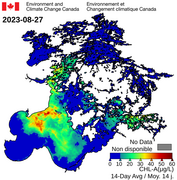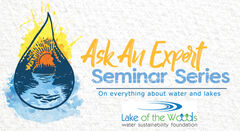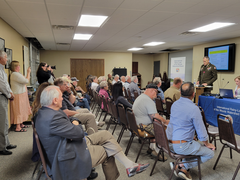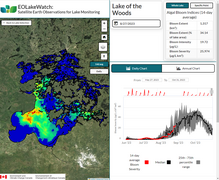If you can't see this e-mail properly, view it online
Add tsellers@lowwsf.com to your address book safe list. |
 |
August Newsletter
|
|
 |
|
|
Algae Bloom 2023 is on its way
After a hot June but cool and sometimes smoky July, the algae bloom on Lake of the Woods started to develop in late July and early August as usual. Blooms began in the southern Big Traverse Bay and in the Morson-Sabaskong area to the south-east. By late August, the bloom covered 34% of the lake and has progressed northward through middle channel to Oak Point. Satellite-derrived measures of chlorophyll-a (a pigment in the algae) ranged above 40 µg/L (red in the satellite image) indicating severe bloom formation in a few locations (anything above 10 µg/L is considered a bloom).
Algal blooms in Lake of the Woods typically peak in the late fall, and progress into the north-central area of the lake. Thus, more extensive blooms are expected to come later, expanding in extent and severity into the fall. Last year, peak severity occurred on October 13, 2022. We’ll have a complete report on the annual bloom conditions later in the fall, once the satellite tracking is complete for the season.


|
|
2023 Ask an Expert Webinar Series: Climate Change in the Rainy - Lake of the Woods Basin
Ask an Expert is a series of free webinars offering viewers a chance to learn from those who study the watershed and work to protect the well-being of our waters and lands. Join us to learn and ask questions about watershed governance, science, traditional knowledge, resource management and more.
After a summer break, the 2023 Ask an Expert seminars resume this fall. Join us on September 11 at 1:00 PM CDT for a session focused on understanding how climate change is impacting the Rainy - Lake of the Woods watershed, with Dr. Scott Higgins (IISD-ELA), Dr. Clare Nelligan (Queens U.), and Dr. Leif Olmanson (U. MN) as they explore the ways in which climate change is already affecting the Rainy-Lake of the Woods basin.


|
|
IJC Watershed Board Public Meetings Report
The IJC’s International Rainy-Lake of the Woods Watershed Board held its annual meetings with the public in Baudette, Minnesota on August 16 and Kenora, Ontario on August 17.
The IJC watershed board presented an update on its activities during the past year and key priorities for the coming year. The board's Aquatic Ecosystem Health Committee is leading several projects this year, including: focus on international water quality objectives and core monitoring design, studies of erosion at the south shore of Lake of the Woods, and reporting of exceedances of water quality criteria.
The board hosted guest updates from the Minnesota Pollution Control Agency and Environment and Climate Change Canada on these agencies’ work to address the phosphorus loading that feeds the excessive algae blooms on Lake of the Woods.


|
|
Second Phase Underway for IJC Watershed Board Review of Water Quality Objectives
The Lake of the Woods Water Sustainability Foundation plays an essential role in coordinating the network of resource management agencies, government partners, and civil society contributors to watershed science and governance. This year, our coordination has been instrumental in driving forward the second phase of a project to develop recommendations for international water quality Objectives and Alert Levels for the Rainy-Lake of the Woods Watershed. The International Joint Commission has oversight responsibilities for water quality in our watershed, so this project will be administered by the IJC watershed board’s Aquatic Ecosystem Health (AEH) Committee, which is co-chaired by the Foundation Executive Director, Todd Sellers.
Objectives are international standards agreed to by Canadian and U.S. governments for boundary waters. Alert Levels are IJC watershed board-adopted trigger thresholds for advising the IJC and governments of issues of potential concern, where there are no international Objectives established.


|
|
IJC Water Quality and Exceedance Report Coming this Fall
Until international phosphorus objectives are agreed to by governments, the IJC watershed board has adopted an interim approach of reporting on exceedances compared to the most stringent water quality criteria used by local state, provincial, or federal agencies for these shared waters.
The IJC watershed board's Aquatic Ecosystem Health Committee co-chaired by LOWWSF's Todd Sellers, is leading the IJC International Rainy-Lake of the Woods Watershed Board’s current compilation of its annual water quality exceedances report. The report draws on monitoring data provided by federal, state and provincial, and Indigenous agencies and will focus on phosphorus and related algae levels on Lake of the Woods and Rainy River, the principal water quality issues of international concern. Phosphorus is the primary nutrient feeding algae blooms and phosphorus loadings to the lake and its main tributary, the Rainy River, has been the focus of intensive studies by Minnesota and Canada.
The report will also present a summary of exceedances or spills (if any) of the permitted wastewater facilities discharging into the Rainy River and Lake of the Woods.
The report should be completed and submitted to the IJC in late fall – we’ll let you know when it is available and have a summary of findings on the Foundation website.

|
|
EOLakeWatch: Satellite Earth Observations for Lake Monitoring – Enhanced version coming soon!
We’ve all seen the compelling satellite pictures of blue green algae blooms covering Lake of the Woods. As part of the Environment and Climate Change Canada’s Lake of the Woods Science Plan (2016-2020), Dr. Caren Binding developed a system to harness these images for near real-time tracking of algae blooms and computation of indices of bloom severity, intensity and extent across the lake. At that time, Dr. Binding launched an online tool, ECCC’s EOLakeWatch, for public access to this information. I highly recommend you check it out!
Coming soon is a “version 2.0” of the EOLakeWatch interactive visualization and data portal for the satellite image processing system. I’ve had an opportunity to view the beta version and am very impressed. It provides ability for the public to display and download maps, charts and data on bloom indices that can be customized to visually show daily values, 14-day averages, and current year blooms compared to the historical values from 2002 and on.


|
|
|
Lake of the Woods Water Sustainability Foundation
 Box 112, Kenora, ON P9N 3X1 Box 112, Kenora, ON P9N 3X1
Todd Sellers, Executive Director
Toll free: 866-370-8891
tsellers@lowwsf.com
|
If you prefer not to receive newsletters please call us toll-free at 866-370-8891 or alternatively click:
Modify your Subscription Options
Not interested any more? Unsubscribe from all
|


 Box 112, Kenora, ON P9N 3X1
Box 112, Kenora, ON P9N 3X1



